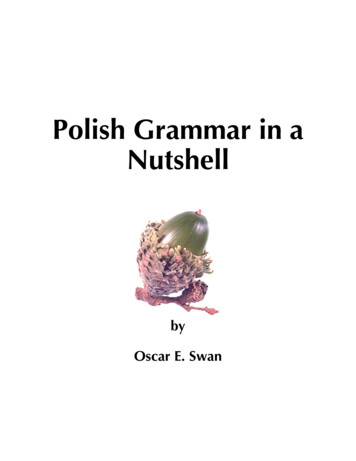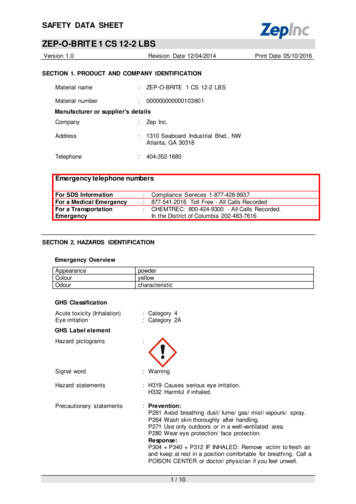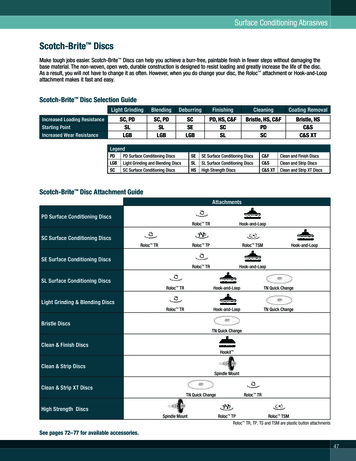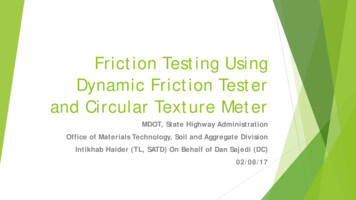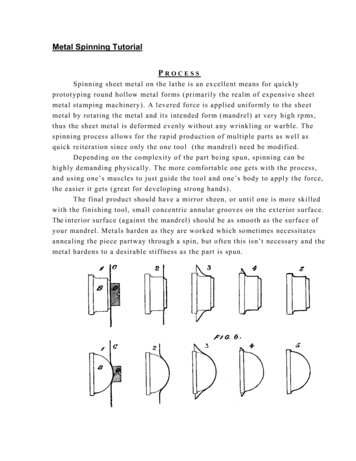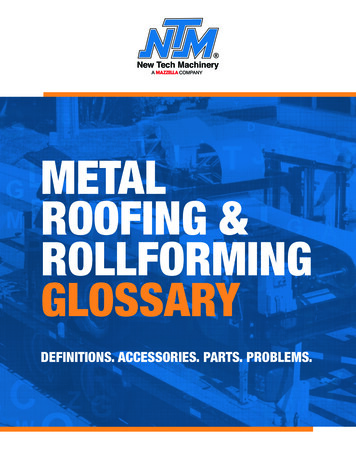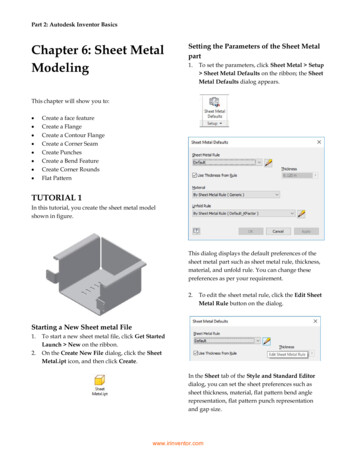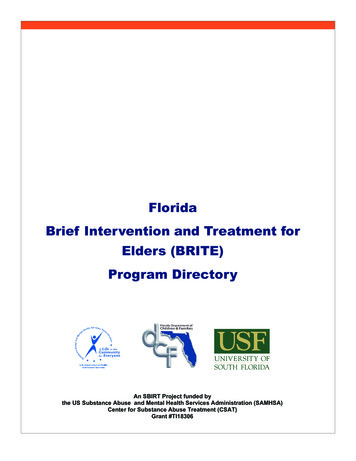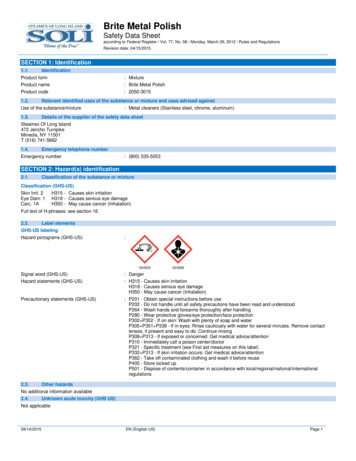
Transcription
Brite Metal PolishSafety Data Sheetaccording to Federal Register / Vol. 77, No. 58 / Monday, March 26, 2012 / Rules and RegulationsRevision date: 04/15/2015SECTION 1: Identification1.1.IdentificationProduct form: MixtureProduct name: Brite Metal PolishProduct code: 2050-30151.2.Relevant identified uses of the substance or mixture and uses advised againstUse of the substance/mixture1.3.: Metal cleaners (Stainless steel, chrome, aluminum)Details of the supplier of the safety data sheetSteamex Of Long Island472 Jericho TurnpikeMineola, NY 11501T (516) 741-56621.4.Emergency telephone numberEmergency number: (800) 535-5053SECTION 2: Hazard(s) identification2.1.Classification of the substance or mixtureClassification (GHS-US)Skin Irrit. 2Eye Dam. 1Carc. 1AH315 - Causes skin irritationH318 - Causes serious eye damageH350 - May cause cancer (Inhalation)Full text of H-phrases: see section 162.2.Label elementsGHS-US labelingHazard pictograms (GHS-US):Signal word (GHS-US): DangerHazard statements (GHS-US): H315 - Causes skin irritationH318 - Causes serious eye damageH350 - May cause cancer (Inhalation)Precautionary statements (GHS-US): P201 - Obtain special instructions before useP202 - Do not handle until all safety precautions have been read and understoodP264 - Wash hands and forearms thoroughly after handlingP280 - Wear protective gloves/eye protection/face protectionP302 P352 - If on skin: Wash with plenty of soap and waterP305 P351 P338 - If in eyes: Rinse cautiously with water for several minutes. Remove contactlenses, if present and easy to do. Continue rinsingP308 P313 - If exposed or concerned: Get medical advice/attentionP310 - Immediately call a poison center/doctorP321 - Specific treatment (see First aid measures on this label)P332 P313 - If skin irritation occurs: Get medical advice/attentionP362 - Take off contaminated clothing and wash it before reuseP405 - Store locked upP501 - Dispose of contents/container in accordance with S052.3.GHS08Other hazardsNo additional information available2.4.Unknown acute toxicity (GHS US)Not applicable09/14/2015EN (English US)Page 1
Brite Metal PolishSafety Data Sheetaccording to Federal Register / Vol. 77, No. 58 / Monday, March 26, 2012 / Rules and RegulationsSECTION 3: Composition/information on ingredients3.1.SubstanceNot applicable3.2.MixtureNameProduct identifier%Classification (GHS-US)Silica(CAS No) 14808-60-720 - 30Carc. 1A, H350Ammonium Hydroxide, aqueous solution, conc 25%(CAS No) 1336-21-61-5Skin Corr. 1B, H314Aquatic Acute 1, H4002-propanol(CAS No) 67-63-01-5Flam. Liq. 2, H225Eye Irrit. 2A, H319STOT SE 3, H336Full text of H-phrases: see section 16SECTION 4: First aid measures4.1.Description of first aid measuresFirst-aid measures general: Never give anything by mouth to an unconscious person. If you feel unwell, seek medicaladvice (show the label where possible).First-aid measures after inhalation: Allow victim to breathe fresh air. Allow the victim to rest.First-aid measures after skin contact: Wash with plenty of soap and water. Wash contaminated clothing before reuse. If skin irritationoccurs: Get medical advice/attention. Specific treatment (see First aid measures on this label).First-aid measures after eye contact: Rinse cautiously with water for several minutes. Remove contact lenses, if present and easy todo. Continue rinsing. Immediately call a poison center or doctor/physician.First-aid measures after ingestion: Rinse mouth. Do NOT induce vomiting. Obtain emergency medical attention.4.2.Most important symptoms and effects, both acute and delayedSymptoms/injuries after inhalation: May cause cancer by inhalation.Symptoms/injuries after skin contact: Causes skin irritation.Symptoms/injuries after eye contact: Causes serious eye damage.4.3.Indication of any immediate medical attention and special treatment neededNo additional information availableSECTION 5: Firefighting measures5.1.Extinguishing mediaSuitable extinguishing media: Foam. Dry powder. Carbon dioxide. Water spray. Sand.Unsuitable extinguishing media: Do not use a heavy water stream.5.2.Special hazards arising from the substance or mixtureNo additional information available5.3.Advice for firefightersFirefighting instructions: Use water spray or fog for cooling exposed containers. Exercise caution when fighting anychemical fire. Prevent fire-fighting water from entering environment.Protection during firefighting: Do not enter fire area without proper protective equipment, including respiratory protection.SECTION 6: Accidental release measures6.1.Personal precautions, protective equipment and emergency procedures6.1.1.For non-emergency personnelEmergency procedures6.1.2.: Evacuate unnecessary personnel.For emergency respondersProtective equipment: Equip cleanup crew with proper protection.Emergency procedures: Ventilate area.6.2.Environmental precautionsPrevent entry to sewers and public waters. Notify authorities if liquid enters sewers or public waters.6.3.Methods and material for containment and cleaning upMethods for cleaning up6.4.: Soak up spills with inert solids, such as clay or diatomaceous earth as soon as possible. Collectspillage. Store away from other materials.Reference to other sectionsSee Heading 8. Exposure controls and personal protection.09/14/2015EN (English US)2/7
Brite Metal PolishSafety Data Sheetaccording to Federal Register / Vol. 77, No. 58 / Monday, March 26, 2012 / Rules and RegulationsSECTION 7: Handling and storage7.1.Precautions for safe handlingPrecautions for safe handling: Wash hands and other exposed areas with mild soap and water before eating, drinking orsmoking and when leaving work. Provide good ventilation in process area to prevent formationof vapor. Obtain special instructions before use. Do not handle until all safety precautions havebeen read and understood.Hygiene measures: Wash hands and forearms thoroughly after handling.7.2.Conditions for safe storage, including any incompatibilitiesStorage conditions: Keep only in the original container in a cool, well ventilated place away from heat, hot surfaces,sparks, open flame and other ignition sources. No smoking. Keep container closed when not inuse.Incompatible products: Strong bases. Strong acids.Incompatible materials: Sources of ignition. Direct sunlight.SECTION 8: Exposure controls/personal protection8.1.Control parameters2-propanol (67-63-0)ACGIHACGIH TWA (ppm)ACGIHACGIH STEL (ppm)ACGIHRemark (ACGIH)200 ppm (2-propanol; USA; Time-weighted averageexposure limit 8 h; TLV - Adopted Value)400 ppm (2-propanol; USA; Short time value; TLV Adopted Value)Eye & URT irr; CNS impairOSHAOSHA PEL (TWA) (mg/m³)980 mg/m³OSHAOSHA PEL (TWA) (ppm)400 ppm8.2.Exposure controlsPersonal protective equipment: Avoid all unnecessary exposure.Hand protection: Wear protective gloves/eye protection/face protection protective gloves.Eye protection: Chemical goggles or safety glasses.Skin and body protection: Wear suitable protective clothing.Respiratory protection: Wear appropriate mask.Other information: Do not eat, drink or smoke during use.SECTION 9: Physical and chemical properties9.1.Information on basic physical and chemical propertiesPhysical state: LiquidColor: whiteOdor: ammonia odorOdor threshold: No data availablepH: 7-8Melting point: No data availableFreezing point: No data availableBoiling point: 212 - 220 FFlash point: 160 FRelative evaporation rate (butyl acetate 1): No data availableFlammability (solid, gas): No data availableExplosion limits: No data availableExplosive properties: No data availableOxidizing properties: No data availableVapor pressure: No data availableRelative density: 1.2Relative vapor density at 20 C: Same as water09/14/2015EN (English US)3/7
Brite Metal PolishSafety Data Sheetaccording to Federal Register / Vol. 77, No. 58 / Monday, March 26, 2012 / Rules and RegulationsSolubility: Soluble in water.Water: Solubility in water of component(s) of the mixture : : :Log Pow: No data availableAuto-ignition temperature: No data availableDecomposition temperature: No data availableViscosity: No data availableViscosity, kinematic: No data availableViscosity, dynamic: No data available9.2.Other informationNo additional information availableSECTION 10: Stability and reactivity10.1.ReactivityNo additional information available10.2.Chemical stabilityStable under normal conditions. Not established.10.3.Possibility of hazardous reactionsNot established.10.4.Conditions to avoidDirect sunlight. Extremely high or low temperatures.10.5.Incompatible materialsStrong acids. Strong bases.10.6.Hazardous decomposition productsFume. Carbon monoxide. Carbon dioxide.SECTION 11: Toxicological information11.1.Information on toxicological effectsAcute toxicity2-propanol (67-63-0)LD50 dermal rabbitLC50 inhalation rat (mg/l)ATE US (dermal)ATE US (vapors)ATE US (dust, mist): Not classified12870 mg/kg (Rabbit; Experimental value; Equivalent or similar to OECD 402; 16.4; Rabbit)73 mg/l/4h (Rat)12870.000 mg/kg body weight73.000 mg/l/4h73.000 mg/l/4hSkin corrosion/irritation: Causes skin irritation.Serious eye damage/irritation: Causes serious eye damage.Respiratory or skin sensitization: Not classifiedGerm cell mutagenicity: Not classifiedCarcinogenicity: May cause cancer (Inhalation).pH: 7 - 8pH: 7 - 8Silica (14808-60-7)IARC group1 - Carcinogenic to humans2-propanol (67-63-0)IARC group3 - Not classifiableReproductive toxicity: Not classifiedSpecific target organ toxicity (single exposure): Not classifiedSpecific target organ toxicity (repeatedexposure): Not classified09/14/2015EN (English US)4/7
Brite Metal PolishSafety Data Sheetaccording to Federal Register / Vol. 77, No. 58 / Monday, March 26, 2012 / Rules and RegulationsAspiration hazard: Not classifiedPotential Adverse human health effects andsymptoms: Based on available data, the classification criteria are not met.Symptoms/injuries after inhalation: May cause cancer by inhalation.Symptoms/injuries after skin contact: Causes skin irritation.Symptoms/injuries after eye contact: Causes serious eye damage.SECTION 12: Ecological information12.1.Toxicity2-propanol (67-63-0)EC50 Daphnia 1LC50 fish 210000 mg/l (48 h; Daphnia magna)9640 mg/l (LC50; OECD 203: Fish, Acute Toxicity Test; 96 h; Pimephales promelas; Flowthrough system; Fresh water; Experimental value)13299 mg/l (EC50; Other; 48 h; Daphnia magna) 1000 mg/l (EC50; UBA; 72 h; Scenedesmus subspicatus)EC50 Daphnia 2Threshold limit algae 112.2.Persistence and degradabilityBrite Metal PolishPersistence and degradabilityNot established.2-propanol (67-63-0)Persistence and degradabilityReadily biodegradable in water. Biodegradable in the soil. Biodegradable in the soil underanaerobic conditions. No (test)data on mobility of the substance available.Biochemical oxygen demand (BOD)1.19 g O₂/g substanceChemical oxygen demand (COD)2.23 g O₂/g substanceThOD2.40 g O₂/g substanceAmmonium Hydroxide, aqueous solution, conc 25% (1336-21-6)Persistence and degradabilityReadily biodegradable in water. Biodegradable in the soil. No (test)data on mobility of thecomponents available. Ozonation in the air.12.3.Bioaccumulative potentialBrite Metal PolishBioaccumulative potentialNot established.2-propanol (67-63-0)Log PowBioaccumulative potential0.05 (Weight of evidence approach; Other; 25 C)Low potential for bioaccumulation (Log Kow 4).Ammonium Hydroxide, aqueous solution, conc 25% (1336-21-6)Bioaccumulative potentialNot bioaccumulative.12.4.Mobility in soil2-propanol (67-63-0)Surface tension12.5.0.021 N/m (25 C)Other adverse effectsEffect on the global warming: No known ecological damage caused by this product.Other information: Avoid release to the environment.SECTION 13: Disposal considerations13.1.Waste treatment methodsWaste disposal recommendations: Dispose in a safe manner in accordance with local/national regulations.Ecology - waste materials: Avoid release to the environment.09/14/2015EN (English US)5/7
Brite Metal PolishSafety Data Sheetaccording to Federal Register / Vol. 77, No. 58 / Monday, March 26, 2012 / Rules and RegulationsSECTION 14: Transport informationDepartment of Transportation (DOT)In accordance with DOTNot regulated for transportTDGNo additional information availableTransport by seaNo additional information availableAir transportNo additional information availableSECTION 15: Regulatory information15.1. US Federal regulationsSilica (14808-60-7)Listed on the United States TSCA (Toxic Substances Control Act) inventory2-propanol (67-63-0)Listed on the United States TSCA (Toxic Substances Control Act) inventoryListed on United States SARA Section 313Ammonium Hydroxide, aqueous solution, conc 25% (1336-21-6)Listed on the United States TSCA (Toxic Substances Control Act) inventoryListed on United States SARA Section 313RQ (Reportable quantity, section 304 of EPA's1000 lbList of Lists)15.2. International regulationsCANADANo additional information availableEU-RegulationsNo additional information availableNational regulationsSilica (14808-60-7)Listed on IARC (International Agency for Research on Cancer)15.3. US State regulationsNo additional information availableSECTION 16: Other informationRevision date: 04/15/2015Other information: None.09/14/2015EN (English US)6/7
Brite Metal PolishSafety Data Sheetaccording to Federal Register / Vol. 77, No. 58 / Monday, March 26, 2012 / Rules and RegulationsFull text of H-phrases:-----Aquatic Acute 1-----Carc. 1A-----Eye Dam. 1-----Eye Irrit. 2A-----Flam. Liq. 2-----Skin Corr. 1B-----Skin Irrit. 2-----STOT SE -H336-----H350-----H400Hazardous to the aquatic environment - Acute Hazard Category 1Carcinogenicity Category 1ASerious eye damage/eye irritation Category 1Serious eye damage/eye irritation Category 2AFlammable liquids Category 2Skin corrosion/irritation Category 1BSkin corrosion/irritation Category 2Specific target organ toxicity (single exposure) Category 3Highly flammable liquid and vaporCauses severe skin burns and eye damageCauses skin irritationCauses serious eye damageCauses serious eye irritationMay cause drowsiness or dizzinessMay cause cancerVery toxic to aquatic lifeHMIS III RatingHealth: 1 Slight Hazard - Irritation or minor reversible injury possibleFlammability: 0 Minimal Hazard - Materials that will not burnPhysical: 0 Minimal Hazard - Materials that are normally stable, even under fire conditions, and will NOTreact with water, polymerize, decompose, condense, or self-react. Non-Explosives.Personal Protection: BB - Safety glasses, GlovesSDS US (GHS HazCom 2012)This information is based on our current knowledge and is intended to describe the product for the purposes of health, safety and environmental requirements only. It should not therefore be construed asguaranteeing any specific property of the product09/14/2015EN (English US)7/7
Product name : Brite Metal Polish Product code : 2050-3015 1.2. Relevant identified uses of the substance or mixture and uses advised against Use of the substance/mixture : Metal cleaners (Stainless steel, chrome, aluminum) 1.3. Details of the supplier of the safety data sheet Steamex Of Long Island 472 Jericho Turnpike Mineola, NY 11501

